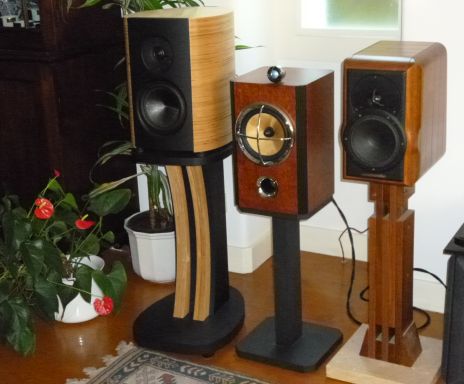Christoph, your Acoustats sound better in your small room, yours is among the top two small rooms I heard, and it takes a load of money to get past that, often taking people in the wrong direction.
That said, the other top room (Lissnr's) is an apogee duetta. Also, your Acoustats, when we brought them down, did not sound the same.
And here we are discussing what's best, and I prefer big apogees bass to any horn I have heard.
I get Bonzos experience between the fundamental difference between horn bass and the kind of bass the big Apogees deliver. For me the Apogees bottom end is a high distinction.
I am drawn to a pure approach in speaker design. Having all drivers the same type and material pays benefit in terms of overall coherency. That choice comes with a price and set its own limitations. No one speaker type is perfect, no one material type is absolutely ideal. But every choice is a compromise in the end so that's all cool, especially once you get over the idea of obtaining unobtainium and that a universal perfect is an ideal and not an actuality.
That said, the nature of the bass that full range larger ribbons can do is something special and rather than just saying it's better I'll just try and describe it as best I can.
Most setups I have heard in some way trip over and don't manage to get an expressive, alive nature to the bass and then in both linear terms, from bottom to top and also in spirit carry this out through the range to make it have a seamless unified perceptual quality with everything seeming whole, complete and unwavering.
It's the coherence and agility of the bass foundation in full panels of ribbon that makes for me a potentially more engaging connection to the qualities of the sound of the music above.
It's nature is unlike any sealed or ported bass that I've heard.
Great bass moves with the music rather than having a static quality to it that comes about when the bass is presented as just too solid.
Ribbon bass has a fluid and lithe nature that seems effortless and keeps pace with the tune. This quality makes enjoying virtually any music type accessible and is preferable in nature for me and reflective of what I hear in real musical performance. It has a poised balance of grace and authority, is not unnecessarily emphatic or strident, and manages to reflect a more natural attack and decay relationship. It is good to dance to.
Speakers that have a blended approach to drivers, where the bass speaker type is fundamentally a different type to the upper range eg. mixing point source with line source, or part dipole, or a rear loaded bass with a front firing mid and tweeter in horns, or just even where the driver material is a mire of mix and match, say paper drivers with either composite or metal is going to have potential impacts on overall coherency. Not to say their aren't benefits in this approach but generally coherence isn't one of those benefits. The more different we make things the less likely they are alike. They can be complimentary but they are not the same. Experiencing presence in music for me is about union rather than separation. The music needs to be whole before we can be one with it.
Not to say that any one approach is going to give you the best outcome in every aspect of music and sound but just that there is always going to be a compromise in which ever route we take.







